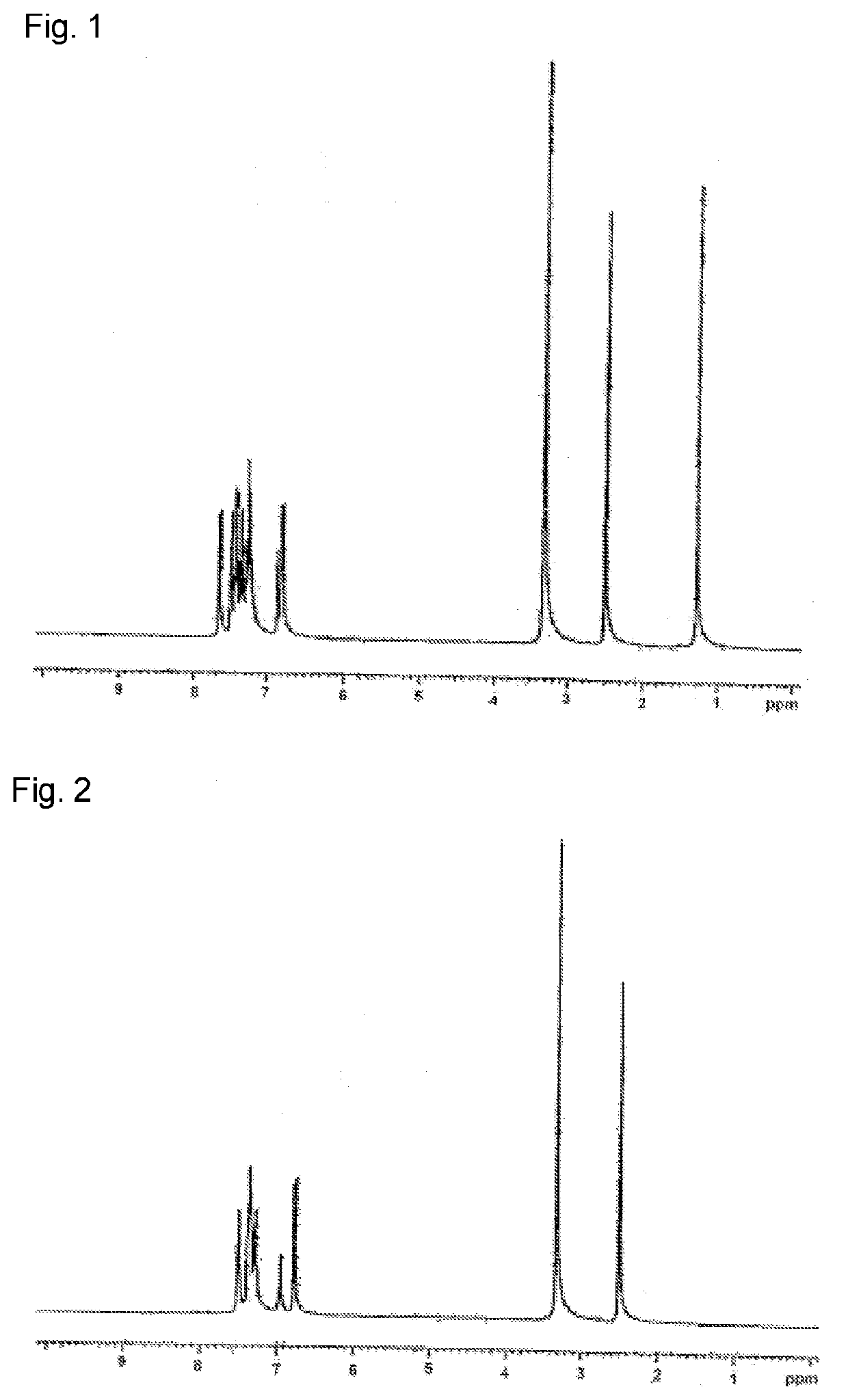Aryldiamine compound and organic electroluminescent element
a technology of organic electroluminescent elements and aryldiamine, which is applied in the field of aryldiamine compound and organic electroluminescent element, can solve the problems of low heat-resistant materials that decompose thermally, deteriorate devices, and insufficient electron blocking ability, and achieve excellent electron blocking properties, large hole mobility, and high hole injection properties.
- Summary
- Abstract
- Description
- Claims
- Application Information
AI Technical Summary
Benefits of technology
Problems solved by technology
Method used
Image
Examples
example 1 — compound 1-2
Example 1—Compound 1-2
Synthesis of 1,2-bis[biphenyl-4-yl(9,9-dimethyl-9H-fluoren-2-yl)amino]benzene
[0208]In a reaction vessel purged with nitrogen were put 24.1 g of biphenyl-4-yl(9,9-dimethyl-9H-fluoren-2-yl)amine, 10.0 g of 1,2-diiodobenzene, 0.2 g of copper powder, 10.5 g of potassium carbonate, and 10 ml of dodecylbenzene. The mixture was stirred under reflux for 72 hours. The resulting reaction mixture was cooled, toluene added thereto to conduct extraction, and the extract filtered to remove insoluble solid, followed by concentration. The concentrate was purified by column chromatography using silica gel as stationary phase and toluene / n-heptane as eluent. The eluate was purified by recrystallization from a CH2Cl2 / acetone mixed solvent to give 15.7 g (yield: 65.0%) of Compound 1-2 as white powder.
[0209]The white powder was analyzed by NMR analysis to identify the structure. As a result, the following 48 signals of hydrogen were observed in 1H-NMR (DMSO-d6). δ (ppm)=7.65 (4H), ...
example 2 — compound 2-1
Example 2—Compound 2-1
Synthesis of 2,2′-bis[di-(4-biphenyl)amino]biphenyl
[0210]In a reaction vessel purged with nitrogen were put 13.9 g of bis(4-biphenyl)amine, 8.0 g of 2,2′-diiodobiphenyl, 0.1 g of copper powder, 6.8 g of potassium carbonate, and 10 ml of dodecylbenzene. The mixture was stirred under reflux for 72 hours, the reaction mixture cooled, toluene added for extraction to remove insoluble matter, the extract filtered, and the filtrate concentrated. The concentrate was purified by recrystallization from a toluene / acetone mixed solvent to yield 10.9 g (70.0%) of Compound 2-1 as white powder.
[0211]The structure of the resulting white powder was identified by NMR analysis. As a result, the following 44 signals of hydrogen were detected in 1H-NMR (DMSO-d6). δ (ppm)=7.50 (8H), 7.39-7.30 (14H), 7.28-7.25 (10H), 6.96 (4H), and 6.76 (8H).
example 3 — compound 2-4
Example 3—Compound 2-4
Synthesis of 2,2′-bis[biphenyl-4-yl-(9,9-dimethyl-9H-fluoren-2-yl)amino]biphenyl
[0212]In a reaction vessel purged with nitrogen were put 15.7 g of biphenyl-4-yl(9,9-dimethyl-9H-fluoren-2-yl)amine, 8.0 g of 2,2′-diiodobiphenyl, 0.1 g of copper powder, 6.8 g of potassium carbonate, and 10 ml of dodecylbenzene. The mixture was stirred under reflux for one week, the reaction mixture cooled, toluene added for extraction to remove insoluble matter, the extract filtered, and the filtrate concentrated. The concentrate was purified by recrystallization from acetone to yield 12.7 g (73.8%) of Compound 2-4 as white powder.
[0213]The structure of the resulting white powder was identified by NMR analysis. As a result, the following 52 signals of hydrogen were detected in 1H-NMR (DMSO-d6). δ (ppm)=7.66 (2H), 7.57 (2H), 7.48-7.14 (24H), 7.02 (2H), 6.83-6.64 (10H), 1.29 (6H), and 1.02 (6H).
[0214]The melting temperature and glass transition temperature of the compounds prepared ...
PUM
| Property | Measurement | Unit |
|---|---|---|
| voltage | aaaaa | aaaaa |
| luminance | aaaaa | aaaaa |
| external quantum efficiency | aaaaa | aaaaa |
Abstract
Description
Claims
Application Information
 Login to View More
Login to View More - R&D
- Intellectual Property
- Life Sciences
- Materials
- Tech Scout
- Unparalleled Data Quality
- Higher Quality Content
- 60% Fewer Hallucinations
Browse by: Latest US Patents, China's latest patents, Technical Efficacy Thesaurus, Application Domain, Technology Topic, Popular Technical Reports.
© 2025 PatSnap. All rights reserved.Legal|Privacy policy|Modern Slavery Act Transparency Statement|Sitemap|About US| Contact US: help@patsnap.com



